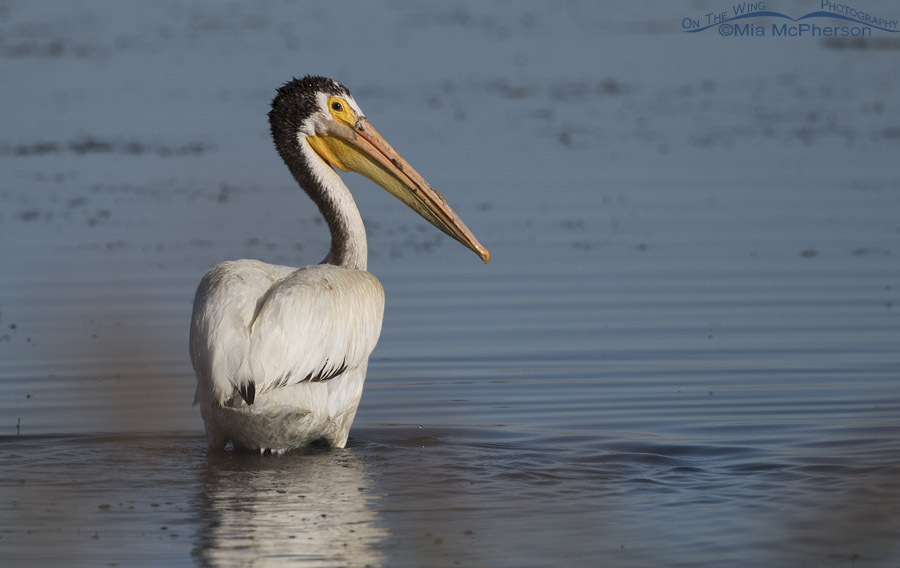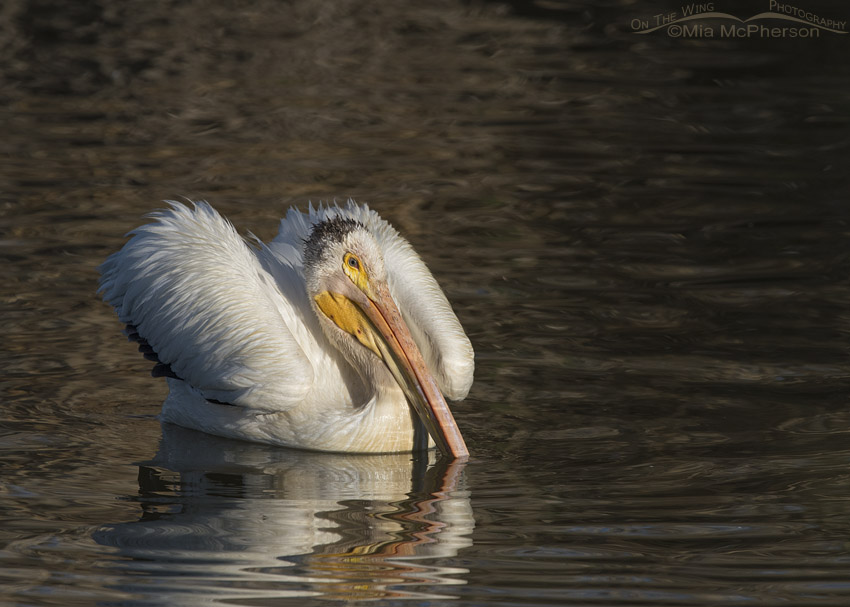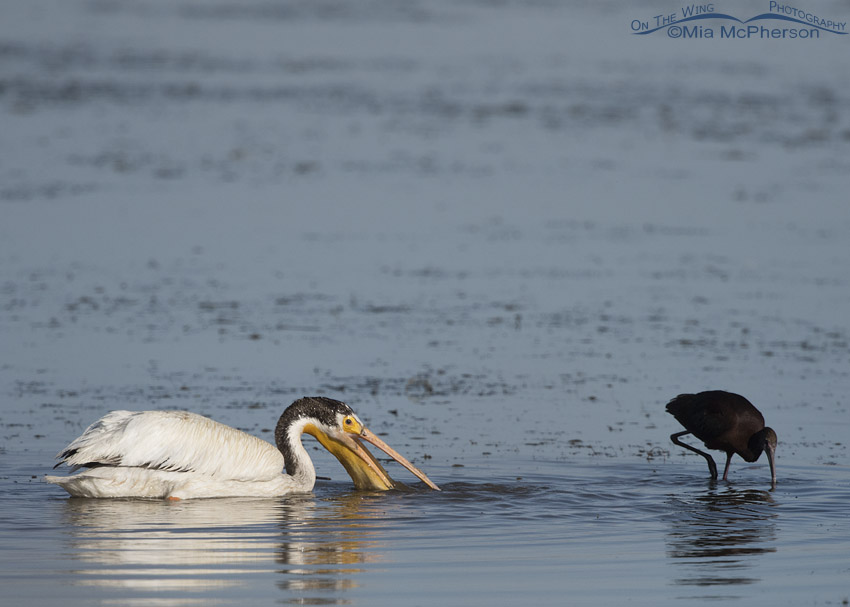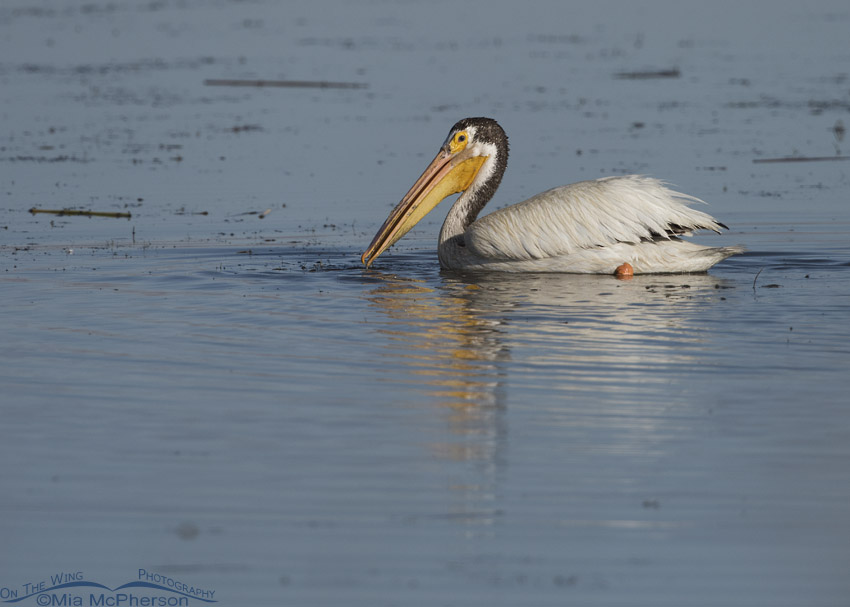 American White Pelican in Supplemental Plumage – Nikon D810, f6.3, 1/6400, ISO 400, -0.7 EV, Nikkor 500mm VR with 1.4x TC, natural light
American White Pelican in Supplemental Plumage – Nikon D810, f6.3, 1/6400, ISO 400, -0.7 EV, Nikkor 500mm VR with 1.4x TC, natural light
Two days ago while on the auto tour loop at Bear River MBR an American White Pelican caught my eyes because of its unusually dark crown, nape, and neck plumage. I just had to photograph it. I have never seen such an extreme variation of supplemental plumage in an American White Pelican and might never again.
 Fluffy American White Pelican in summer plumage – Nikon D810, f8, 1/3200, ISO 400, -0.7 EV, Nikkor 500mm VR with 1.4x TC, natural light
Fluffy American White Pelican in summer plumage – Nikon D810, f8, 1/3200, ISO 400, -0.7 EV, Nikkor 500mm VR with 1.4x TC, natural light
There is some expected variation in the Supplemental Plumage of American White Pelicans in the amount of dark feathers on the crown and nape. The pelican above shows a more “normal” Supplemental (summer) Plumage. Note the sparsity of the dark feathers on the crown compared to the pelican I photographed two days ago.
 Side view of an American White Pelican in an extreme variation of Supplemental Plumage – Nikon D810, f6.3, 1/5000, ISO 400, -0.3 EV, Nikkor 500mm VR with 1.4x TC, natural light
Side view of an American White Pelican in an extreme variation of Supplemental Plumage – Nikon D810, f6.3, 1/5000, ISO 400, -0.3 EV, Nikkor 500mm VR with 1.4x TC, natural light
The nearly black feathers of the unusual pelican I photographed two days ago extend way down its neck and it also covers a large portion of the back of the pelican’s head. I also noticed that the iris of this bird is very dark as well.
 American White Pelican in Summer or Supplemental Plumage – Nikon D810, f6.3, 1/5000, ISO 400, -0.3 EV, Nikkor 500mm VR with 1.4x TC, natural light
American White Pelican in Summer or Supplemental Plumage – Nikon D810, f6.3, 1/5000, ISO 400, -0.3 EV, Nikkor 500mm VR with 1.4x TC, natural light
After coming home and looking at the images I took of this pelican I searched the internet and couldn’t find another image that showed this much of a variation in this plumage phase in American White Pelicans. Images may be out there, I just could not find them. I also don’t know what would cause an extreme variation like this.
I had to laugh though because it looks like this pelican has been hanging out with Western and Clark’s Grebes at the refuge for too long because they also sport the dark stripe running from their crowns down the backs of their necks.
I never know what I will see when I am out in the field with birds.
Life is good.
Mia
Click here to see more of my American White Pelican photos plus facts and information about this species.


An avian trend setter?
Juvenile pelicans have dark eyes they go a pale blue as they mature. Could it be a darker morph juvenile?
April, this is an adult, if you look closely at the bill you can still see a bump where the caruncle or horn was during the breeding season. I have noticed that the eye color of American White Pelicans seems to change some during breeding and non-breeding season but nothing this drastic. This bird seems unique!
I really like the color pattern of this bird…a handsome variation of the species…lmuch ikeo the residents of Hollywood….
White pelicans hold a special place in my heart. They kept me sane-ISH back when I lived in Dallas, adjacent to White Rock Lake Park, and I had surgery on both feet. About when I was about to climb the walls, the significant other took me to the park where I could watch the wintering white pelicans do that absolutely amazing flock thing. The flock thing is amazing in and of itself, but with the huge white pelicans, it was an outrageously beautiful sight. About an hour of watching them, and the other birds in that wonderful park, and I was good to go for another 24 hours without entirely losing my mind!
I’ve never seen that color variation, either but if I had to guess, I’d think it was just how the DNA stacked up on that particular individual. But what do I know?
Beautiful images Mia.
Very interesting!